Or search by topic
Number and algebra
Geometry and measure
Probability and statistics
Working mathematically
Advanced mathematics
For younger learners
Published 2020 Revised 2022
The Importance of Shape and Space in the Early Years
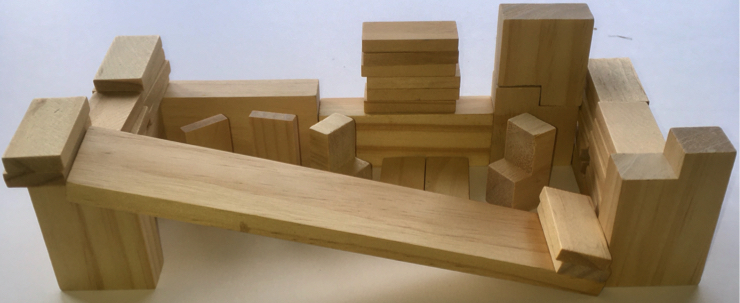
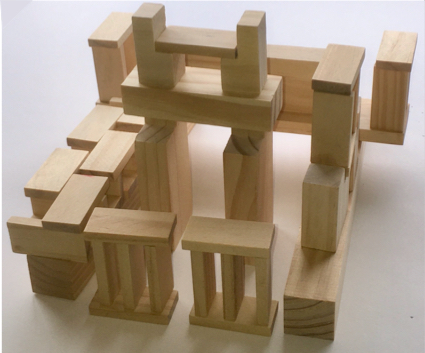
We used to focus a lot on blockplay in the early years, with some impressive results. In recent years there has been an increasing amount of research demonstrating that children's early spatial thinking predicts their mathematical achievement and understanding. At the same time, 'Shape, space and measures' seems to have had less attention, perhaps as a result of a focus on number sense,
culminating in proposals to remove this area from the assessed early years curriculum in England.
Much research has shown that young children's spatial rather than numerical abilities predict their overall mathematics achievement: the key skills are visualising what shapes will look like when they are combined or rotated (Young et al., 2018). A number of studies have also shown that these abilities are not innate, but teaching young children spatial skills actually improves their maths, including their number understanding and general thinking skills. This led one research group to conclude:
Improving spatial experiences prior to school entry is likely to increase children's readiness for school”¦.Optimizing spatial performance may be an underutilized route to improving mathematics achievement. (Verdine et al,2017: 93,102)
A focus on shape and space may provide a more accessible route to mathematics for some children, rather than focusing mainly on numbers. It may also help some groups (for instance, poorer children and girls) who may be disadvantaged with regard to outdoor and spatial play resources.
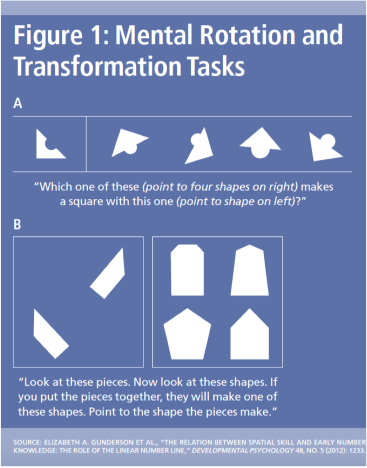
Studies using tests like the one above have found that five year olds' success with these predicts their later maths achievement (Gunderson et al, 2012). These activities typically involve selecting a shape which combines with another to form a square, or predicting which shape will be made when shapes are combined. To solve these, you need to analyse the shapes, for instance in terms of the position and amount of circle shown, or to compare angles and lengths of sides, then mentally rotate and fit shapes together. It is interesting to note that the usual shape names, such as 'circle' and 'square', are not very useful: you may find yourself talking about 'bulginess of bobbles' or 'slopey sides' and using gestures to help. The research suggests that vocabulary about shape properties, such as sides, edge and corner, (Pruden et al, 2011) help children to identify the key features of shapes, enabling them to focus on mentally rotating the shapes. The key early experiences likely to develop such abilities would seem to be obvious - jigsaw puzzles and construction - and this is what research has found.
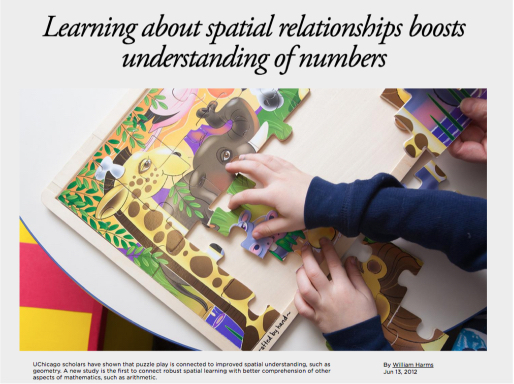
Picture credit: http://news.uchicago.edu/story/learning-about-spatial-relationships-boosts-understanding-numbers
It is however, not totally obvious why mentally rotating shapes should help children's number understanding. It seems that developing the general ability to visualise spatially helps children to visualise numbers spatially, as on a number line. We use this facility to visualise a range of number relations, which helps us to understand and create diagrams, graphs and maps. Spatial visualisation is linked to body awareness and mentally mapping our surroundings, and also to creating and interpreting 2D representations of 3D shapes and spaces, including pictures and models. One of the most intriguing pieces of research found that children's ball skills predicted their maths achievement, in a study involving six year olds playing a computer game. Giles et al (2018) suggested that the ability to anticipate the trajectory and speed of a ball and to move a bat to meet it (or 'interceptive timing') involved superior visualising skills which are also used in visualising mathematical relations.
How might spatial images help children learn number sense?
A key visual-spatial skill that helps young children understand numbers, is subitising, or the ability to recognise how many things there are without counting, by memorising visual arrangements. Representing numbers with fingers, and knowing the 'five-and-a bit' structure of numbers like six and seven, involves visual and kinaesthetic subitising, which is also linked to body awareness and the way fingers and numbers are represented in the brain. For some children, the finger image conveys a stronger number meaning than a word, so they can get the right answer with their fingers, while saying the wrong word.
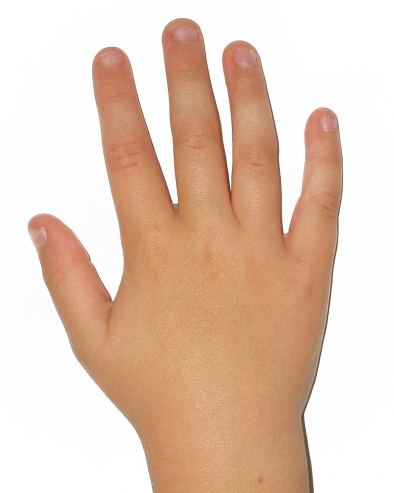
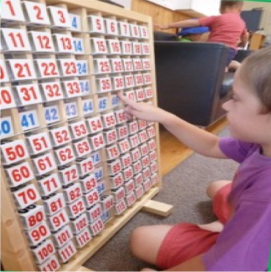
Counting involves spotting patterns, which may also be represented visually, on a number line or square. Playing track games has been shown to develop children's understanding of relative number size, (Laski & Siegler, 2014) as children learn that numbers further along the track are worth more. The 'staircase' image links the counting sequence to numbers increasing in size, and also shows the way each number includes the previous one, plus one.

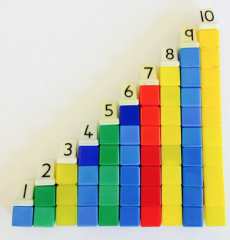
These ideas about numbers are represented by objects taking up more space: early experiences of comparing amounts of length, area, volume and weight all contribute to children's comparison of numbers of objects, involving spatial and body awareness, for instance in feeling weight. Later children have to learn to distinguish numerosity from volume, for instance when estimating how many things are in a jar, which involves taking into account the size of objects and imagining those hidden from view. In this way, early experiences of comparing different aspects of measures underpin children's ability to compare numbers. (See the Early Years activity I have a Box.)

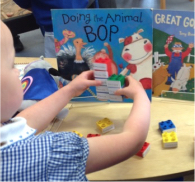
When children come to learn about number composition, or numbers being made up of smaller numbers, spatial experiences are important because they provide memorable visual patterns and physical experiences of rearranging manipulatives (including fingers) to construct and connect images.
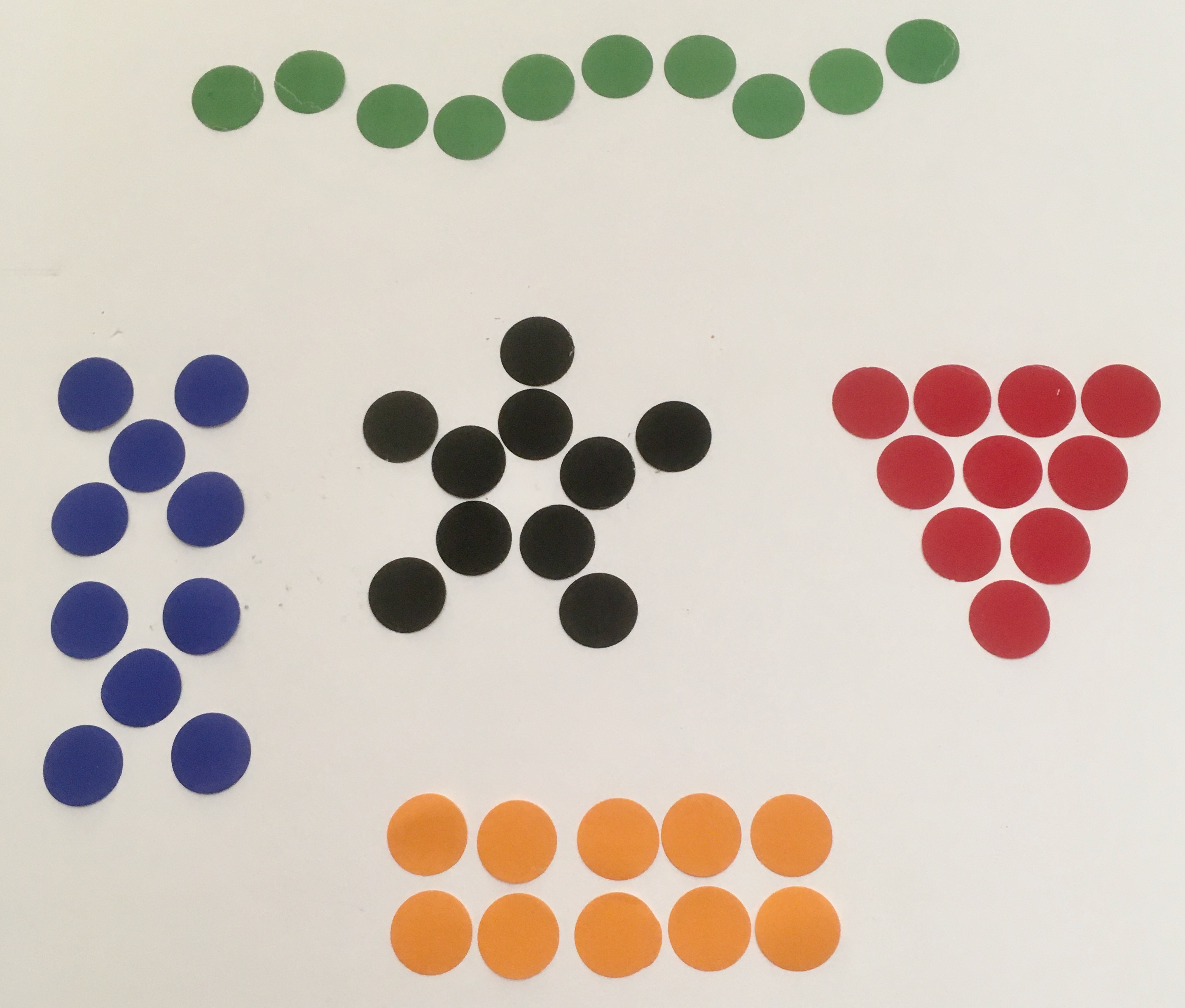
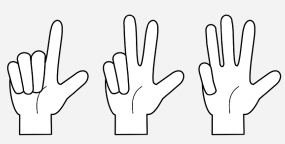
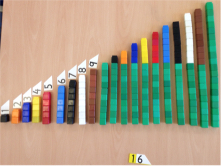
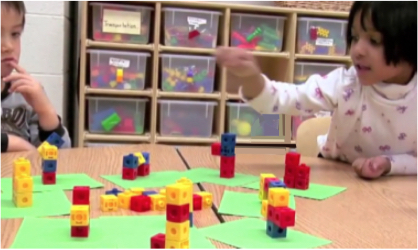
An activity which involves both numerical and spatial composition is to make different models with five interlocking cubes, which engages children in discussing five as made up of 'two on each side and one in the middle' and reasoning that models 'will be the same if this one is turned the other way up'. (See: Erikson Early Mathematics Collaborative Number arrangements.)
Spatial activities to improve children's mathematics
One teaching programme with four to seven year olds included activities like copying drawings and making models from memory, and barrier games, where one child has to describe a model for another child to make on the other side of the screen (Hawes et al. 2017).
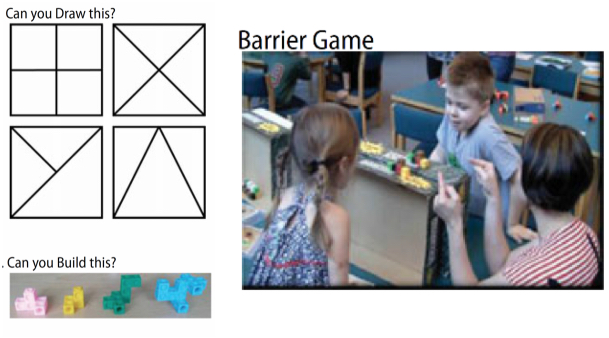
Younger children may find it sufficiently challenging to copy a drawing or model which is in front of them. Research also suggests that puzzle play generally improves children's spatial thinking, as they identify the features of pieces and physically rotate them to fit. It also suggests that providing increasingly challenging puzzles and actually teaching children puzzle-solving strategies, will develop children's spatial skills. Shape puzzles can progress from shape sorters and insert puzzles to jigsaw puzzles with more pieces and greater complexity. Construction play, including Lego, has also been shown to predict children's spatial reasoning and mathematics attainment, suggesting that we should encourage children to make constructions of increasing complexity.
Adults' use of spatial language is also linked to children's spatial reasoning, and this increases when they are engaged together in an activity with a goal, such as solving a puzzle or trying to make a specific model from an example or a picture (Verdine et al, 2017). This suggests that educational activities should include these goal-oriented puzzles as well as free play with shapes, as they will focus attention and encourage more specific language about the shapes and positions involved. Two examples of early shape challenges are shown by Erikson: in one a child needs to rotate shapes to copy a model, in the other, the child is using pattern blocks to make star shapes and is delighted to discover a variety of ways involving rhombuses, triangles, a hexagon and trapezium (Erikson Early Mathematics Collaborative). (Pattern blocks are very chunky and easier for young children to handle than thinner plastic '2D' shapes.)
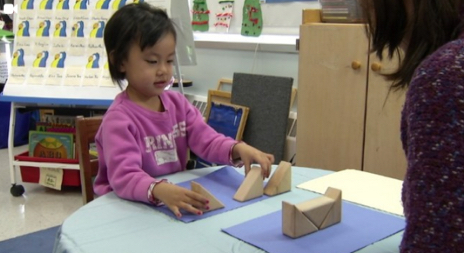
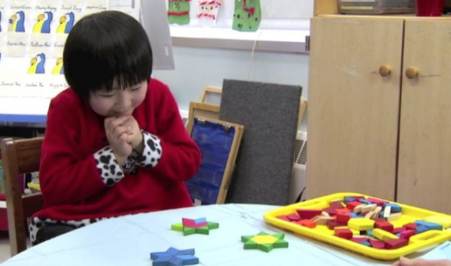
Transforming 3D shapes with child 36 Composing Shapes with child 12
Developing children's spatial thinking therefore implies more adult involvement than perhaps we have been used to, considering children's puzzle and shape play as independent, creative problem solving. We could increase children's repertoire of strategies and vocabulary, describing shape properties, with terms such as edge, corner and side, as well as using informal language such as 'curvy', 'sloping', 'sticking out' and 'roof shaped'. This implies that we should be aware of learning trajectories for shape and puzzle play, and vocabulary. For instance, positional concepts such as 'between' seem to be harder than 'on top of' and 'underneath', while relational terms which depend on the position of the viewer, such as 'in front of' and 'behind', are harder still. If we know roughly where children are along such trajectories, we can help them to progress to more complex and sophisticated spatial thinking. Clements and Sarama (2009: 153/4; https://www.learningtrajectories.org/) offer learning trajectories for shape play, including construction:
Age 2-3: stacking, assembling pieces 
Age 3-4: composite shapes eg arches; trial and error 
Age 4-5: plans composite shapes, towers of arches 
Age 5-6: complex with repeated units; stairs 
Age 6-8: units of units; ceilings 
Key aspects include planning and visualising, by gathering blocks together before building, or making composite shapes out of other shapes and then making repeated units or more complex structures such as stairs. Clements and Sarama suggest that children building with older children, or being prompted to produce more complex structures would help develop blockplay. One study (Schmitt et al, 2018) found that giving children specific challenges, such as building a boat or a bridge, improved both their mathematics and their executive functioning, as shown by their ability to focus and think flexibly: hence the suggestion that this might increase school 'readiness'.
All of this suggests that we need to increase teaching of spatial mathematics and widen it to include more than free play and the naming of shapes which it may sometimes become. Research endorses the main areas of shape and space as at present, but proposes a greater focus on combining and decomposing shapes, describing a wider range of shape properties and including teaching support to solve goal-oriented puzzles and activities. Spatial learning begins with children's body awareness and own movement in space as they build mental maps of their surroundings and develop concepts to identify positions and directions, like 'between' or 'forwards and backwards'. Learning progresses as children can visualise locations, predict the results of movements and interpret models and drawings, leading to the construction and understanding of maps and diagrams later. This means that children's physical movement indoors and out is also important to their mathematics, as the 'ball catching' study suggests. In the Netherlands, Freudenthal (1971:418) recommended that geometry should start “as a science of physical space, of the space in which the child lives and moves, as an organization of the learner's spatial experiences” (cited by Sinclair and Bruce, 2015: 321). Important activities therefore include running or scootering around outdoors (see the activity Scooters, Bikes and Trikes), following, remembering and constructing routes, with obstacle courses, treasure hunts and outings playing an important part, alongside small world play (see the activity Small World Play) with town and railtrack layouts or storying involving relocation and journeys. Erikson suggests several books which focus on these ideas, such as Grandpa's Quilt, which involves rearranging a patchwork quilt to make a new shapes or Lucy in the City, which describes a lost racoon's attempts to find her way home.
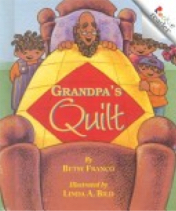
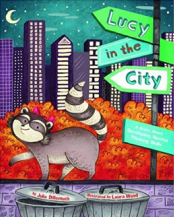
The Spatial Reasoning Toolkit (produced by the Early Childhood Maths Group with the University of Surrey) provides a useful collection of resources, including a learning trajectory from birth to seven years with suggested activities, children’s booklists and explanatory videos, as well as printable posters for practitioners working with different age groups.
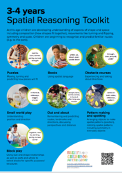
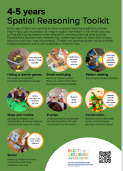
Research about the importance of spatial reasoning for mathematics suggests a much richer early years curriculum for children, with greater adult involvement in identifying and supporting children's spatial thinking, in order to provide them with greater enjoyment and understanding of mathematics.
Children's books
Grandpa's Quilt by Betsy Franco
Lucy in the City by Julie Dillemuth
Weblinks
Erikson Early Mathematics Collaborative: https://earlymath.erikson.edu/ideas/
Learning trajectories: https://www.learningtrajectories.org/
Early Childhood Maths Group: https://earlymaths.org/spatial-reasoning
See also the Espresso research summary 27 on spatial skills, published by Cambridge Mathematics
References
Clements . D.H. & Sarama, J. (2009). Learning and teaching early math: the learning trajectories approach. Abingdon: Routledge
Gunderson, E., Ramirez, G., Beilock, S.L. & Levine, S.C. (2012) The relation between spatial skill and early number knowledge: The role of the linear number line. Developmental Psychology, 48(5) 1229-1241, doi: 10.1037/a0027433
Gura, P. (1992) Exploring learning: The Froebel blockplay project. London: Paul Chapman.
Hawes, Z., Moss, J., Caswell, B., Naqvi, S. & MacKinnon, S. (2017). Enhancing children's spatial skills through a dynamic spatial approach to early geometry instruction: effects of a 32 week intervention. Cognition and Instruction, 35 (3) 236-264 doi: 10.1080/07370008.2017.1323902
Laski, E.V. & Siegler, R.S.(2014) Learning from number board games: you learn what you encode Developmental Psychology 50 (3) 853-864 doi: 10.1037/a0034321
Schmitt, S.A., Korucu, I., Napoli, A.R., Bryant, L.M. & Purpura, D.J. (2018) Using block play to enhance preschool children's mathematics and executive functioning: A randomized controlled trial. Early Childhood Research Quarterly, 44 181-191
Sinclair, N. & Bruce, C.D. (2015) New opportunities in geometry education at the primary school ZDM: the International Journal on Mathematics Education 47:319-329 doi: 10.1007/s11858-015-0693-4
Verdine, B.N., Golinkoff, R. M., Hirsh-Pasek, K. & Newcombe, N. S. (2017) Links betwee Spatial and Mathematical Skills across the Preschool Years. Monographs of the Society for Research in Child Development, 82, no. 1 (March): 1-150. http://onlinelibrary.wiley.com/doi/10.1111/mono.v82.1/issuetoc.
Young, C.J., Levine, S.C. & Mix, K.S. (2018). The Connection Between Spatial and Mathematical Ability Across Development. Frontiers in Psychology, 04 June. https://doi.org/10.3389/fpsyg.2018.00755

